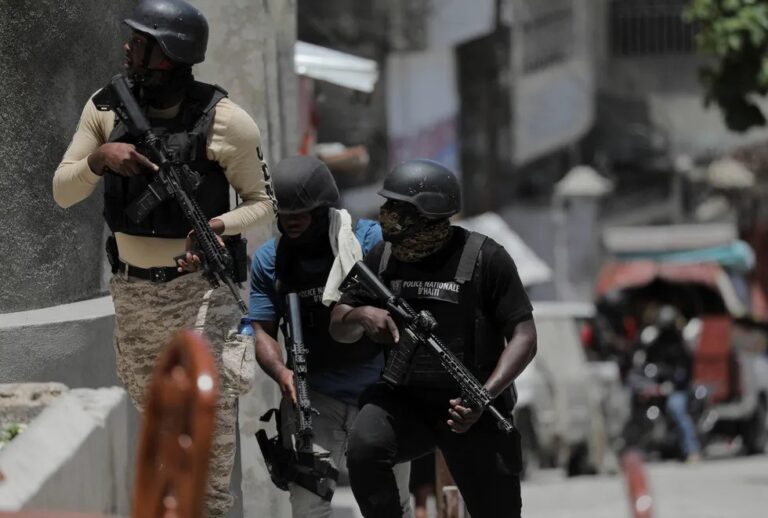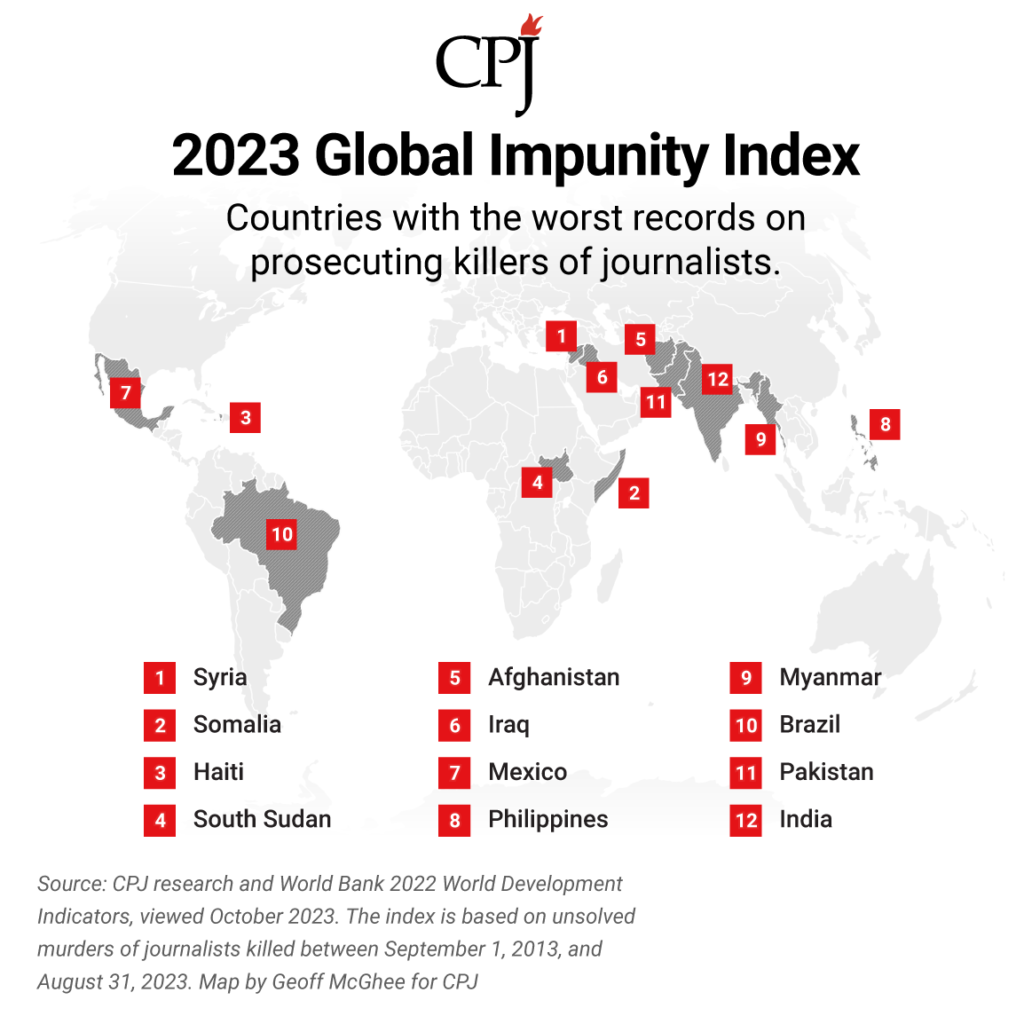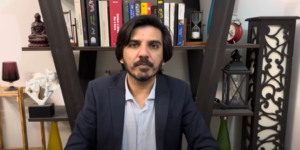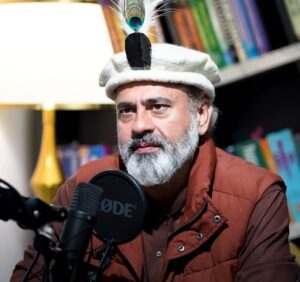
Haiti, amidst a backdrop of crises, has emerged as one of the nations where perpetrators of violence against journalists often evade justice, according to the 2023 Global Impunity Index released by the Committee to Protect Journalists (CPJ). The country’s first appearance on CPJ’s annual list is attributed to a dire combination of factors including rampant gang violence, enduring poverty, political instability, and a malfunctioning judicial system.
In the latest index, Haiti now holds the unenviable position as the third-worst offender globally in terms of impunity, trailing behind Syria and Somalia. Notably, Somalia, Iraq, Mexico, the Philippines, Pakistan, and India have consistently featured on the index since its inception, showcasing the entrenched nature of impunity in these regions. Additionally, Syria, South Sudan, Afghanistan, and Brazil have also maintained their presence on the list over the years, serving as a stark reminder of the persistent challenges in combating impunity worldwide.
The failure to prosecute those responsible for the killings of journalists in these countries stems from a variety of factors, spanning from ongoing conflict to systemic corruption, insurgency, inadequate law enforcement, and a lack of political will to hold perpetrators accountable. These nations encompass both democracies and autocracies, ranging from states in turmoil to those with relatively stable governance structures. Even in regions emerging from prolonged periods of warfare, the cessation of hostilities has not translated into an end to the persecution of journalists.
As impunity becomes ingrained, it sends a dangerous signal of indifference that is likely to embolden future assailants and undermine independent journalism. This trend has prompted a concerning response among journalists, with many either fleeing their countries, scaling back their reporting, or abandoning the profession altogether.
The latest index, covering the period from September 1, 2013, to August 31, 2023, documents 261 journalists who were murdered in connection with their work. Shockingly, in more than 78% of these cases—204 incidents—no one has been held accountable over the past decade.
(Journalists killed during the Israel-Hamas conflict that commenced on October 7 are excluded from this analysis as their deaths occurred outside the 10-year index period.)

The current 78% impunity rate marks a modest improvement from the 90% rate recorded by CPJ a decade ago. However, this should not be interpreted as grounds for optimism. Impunity persists at an alarming rate, with nearly four out of every five perpetrators of journalist killings evading justice.
Since CPJ began tracking journalist murders in 1992, a total of 956 cases have been documented. Shockingly, 757 of these cases, constituting over 79%, have remained entirely unresolved.
CPJ’s impunity index focuses on countries where there have been at least five unsolved journalist murders over a 10-year period. Only cases with complete impunity are included; instances where some perpetrators have been convicted while others remain free—partial impunity—are excluded. The ranking of each country is determined relative to its population size, resulting in more populous nations like Mexico and India appearing lower on the list despite recording a higher number of journalist murders.

However, the harmful consequences of impunity extend far beyond the nations recurrently listed on CPJ’s yearly index. Unaddressed journalist killings cast a chilling shadow over local journalists worldwide, eroding press freedom and diminishing reporting on matters of public interest.
In the Palestinian territories of the Israeli-occupied West Bank, Palestinian journalists, as revealed in CPJ’s “Deadly Pattern” report published earlier this year, expressed heightened concerns for their safety following the fatal shooting of Al-Jazeera Arabic correspondent Shireen Abu Akleh by the Israel Defense Forces in May 2022. CPJ’s investigation uncovered that no one had been held accountable for the deaths of 20 journalists killed by Israeli military fire over the span of 22 years. According to the report, “The impunity in these cases has severely undermined the freedom of the press, leaving the rights of journalists in precarity.”
Israel is not featured in the impunity index as fewer than five journalists targeted for murder were killed during the index period.
In several European Union countries, traditionally considered safe havens for journalists, press freedom has faced mounting challenges, with unresolved journalist murders in Malta, Slovakia, Greece, and the Netherlands.
In Malta and Slovakia, the quest for complete justice in the cases of Daphne Caruana Galizia and Ján Kuciak remains unresolved. Greece has yet to see anyone held accountable for the 2010 murder of Sokratis Giolias, as highlighted in a recent report by “A Safer World for the Truth,” a coalition of rights organizations, including CPJ. The report identified shortcomings in authorities’ investigations into both Giolias’ murder and the similar killing of Giorgos Karaivaz 11 years later.
In the Netherlands, nine suspects are currently awaiting trial for the fatal shooting of Dutch reporter Peter R. de Vries as he exited a TV studio in 2021. While the motives behind the killings of De Vries and Karaivaz remain unclear, colleagues in Greece and Holland have shared with CPJ that their deaths have instilled lingering insecurity and self-censorship within the media community. Paul Vugts, a Dutch crime reporter who became the first journalist in the Netherlands to receive full police protection due to work-related death threats, described De Vries’ death as having “a chilling effect on journalists.”
In countries where journalists face greater risks, violent reprisals for their reporting persist.
In Cameroon, located in central Africa, the mutilated body of journalist Martinez Zogo was discovered on January 22, 2023. Just 12 days later, another journalist with connections to Zogo, Jean-Jacques Ola Bebe, was also found dead. Following warnings from Zogo that they were on a hit list, several journalists fled the country, while others resorted to self-censorship. A report submitted to the United Nations in July by a coalition including CPJ highlighted the ongoing killing, physical assaults, abductions, torture, and harassment of journalists by Cameroonian authorities and non-state actors, which continue to severely inhibit press freedom.
Way to Proclaiming Justice
Securing justice for murdered journalists has been an arduous journey. Since 1992, only 47 cases, representing fewer than 5% of all murders, have seen full accountability. CPJ’s data underscores the pivotal influence of factors such as international pressure, the application of universal jurisdiction, and shifts in governmental leadership in facilitating the attainment of justice in these cases.
Peruvian journalist Hugo Bustíos Saavedra’s case stands as a landmark example. Bustios was killed in a military ambush on November 24, 1988, while reporting on the conflict between government forces and Shining Path guerrillas. Nearly 35 years later, a Peruvian criminal court sentenced Daniel Urresti Elera, the former army intelligence chief in the region where Bustios was killed, to 12 years in prison for his involvement in the murder. Urresti’s conviction resulted from a confluence of factors including shifting political dynamics within Peru, the reopening of investigations into human rights violations following the effective annulment of the 1995 amnesty law shielding military officers, and continued advocacy by rights organizations—among them, CPJ—at the Inter-American Commission on Human Rights.
In the Central African Republic, the recent death of Yevgeny Prigozhin, the leader of a Russian private mercenary group, has sparked hopes that individuals with knowledge of the 2018 murders of three Russian journalists may come forward. Orkhan Dzhemal, Kirill Radchenko, and Aleksandr Rastorguyev were fatally shot three days after arriving in the country to investigate the activities of Wagner, the private military company associated with Prigozhin.
Universal jurisdiction, which empowers a country to prosecute crimes against humanity regardless of where they occurred, can serve as a potent instrument. For instance, Bai Lowe, accused of belonging to the “Junglers” death squad responsible for the killing of Gambian journalist Deyda Hydara, is currently standing trial in Germany. This marks the first instance of an individual accused of human rights abuses during Yahya Jammeh’s dictatorship being prosecuted outside of Gambia.
Additionally, international pressure can compel authorities to investigate unresolved cases of journalist killings, even if such investigations do not necessarily result in prosecutions. CPJ’s “Deadly Pattern” report, which examined journalists killed by the Israeli military, revealed that authorities were more inclined to investigate the killings of journalists holding foreign passports. The report observed, “The extent to which Israel investigates, or claims to investigate, journalist killings seems to be influenced by external pressure.”
While cases like that of Bustios offer a glimmer of hope, they also highlight the long and arduous path to justice—one that, sadly, remains elusive for the majority of murdered journalists.
Further insights into nations featured on the index:
Syria
In Syria, fourteen journalists were killed with complete impunity during the index period of 2023. Among them, ten lost their lives between 2013 and 2016, a tumultuous period when the initial uprising against the Bashar al-Assad regime evolved into a full-fledged conflict involving regional and global powers. During this time, the militant group Islamic State (IS) gained prominence and is believed to be responsible for the murders of eight out of the ten journalists killed. While the intensity of fighting has subsided since Assad regained control over most of the country, Syrian media outlets have faced significant challenges. Many journalists have been forced into exile, and those who remain face ongoing harassment, threats, and detention by military authorities.
Details
Somalia
Somalia dropped below Syria in the 2023 index, relinquishing its status as the worst offender for the past eight years. However, this change does not signify an improvement in Somalia’s record of impunity. Rather, it stems from the methodology used to calculate the rankings: three of the four journalists murdered in 2013 were killed before September 1 of that year, falling outside the index period. Most of the 11 journalists killed during the index period, spanning from 2013 to 2018, are believed to have been targeted by Al-Shabaab, an insurgent group aiming to establish an Islamic state in Somalia. Despite ongoing efforts to combat Al-Shabaab, Somalia remains unstable. Reporting on the insurgent group remains perilous, with journalists facing arrests, threats, and harassment, severely impeding media coverage.
Haiti
Haiti’s inclusion in the index is a result of the unresolved murders of six journalists since 2019. The majority of these killings occurred in 2022 and 2023, during a period of heightened violence in which criminal gangs, having seized control of significant parts of Haiti, were responsible for hundreds of deaths. These events unfolded against the backdrop of Haiti’s ongoing struggle to navigate an economic crisis exacerbated by a series of natural disasters. Furthermore, the political vacuum created by the 2021 assassination of President Jovenel Moïse has left the country in a state of uncertainty. Haitian journalists have been particularly vulnerable, with reports of kidnappings and forced displacements from their homes due to fears that their reporting puts them at greater risk than other civilians.
South Sudan
In South Sudan, the five journalists who were killed all perished in an ambush carried out by unidentified gunmen targeting an official convoy in Western Bahr al Ghazal state on January 25, 2015. The media landscape in South Sudan has faced sustained pressure within a country marked by civil unrest and widespread human rights violations since achieving independence in 2011. CPJ has extensively documented cases of harassment, arbitrary detention, imprisonment, and even the death of a war reporter caught in crossfire in recent years.
Mexico
While the number of journalist killings in Mexico has decreased from last year’s peak, the country continues to rank among the most perilous for journalists globally. Out of the 23 journalists murdered during the index period, seventeen are believed to have been victims of criminal violence. CPJ’s investigations indicate that the pervasive violence targeting journalists can be partly attributed to the lack of effective measures by both state and federal authorities to enhance the safety of reporters or to adequately address crimes against the press.
Afghanistan
The militant Islamic State has asserted responsibility for the deaths of 13 out of the 18 journalists murdered in Afghanistan over the past decade. Notably, ten journalists lost their lives in 2018 alone, with nine falling victim to a double suicide bomb attack in Kabul on April 30 of that year, and one being fatally shot the preceding week in Kandahar. Although the targeted killings of reporters have seemingly decreased since the Taliban regained control in 2021, a significant exodus of journalists from the country has occurred due to the group’s escalating repression. Consequently, Afghanistan’s once-thriving media environment has been severely compromised.
Iraq
CPJ’s records show no documented cases of journalists being murdered for their work in Iraq since 2017. Among the 17 journalists listed in CPJ’s database, fourteen were killed in 2013 and 2015 during a period marked by a resurgence of sectarian violence. Despite a reduction in violence, media restrictions persist, and journalists, particularly in Iraqi Kurdistan, continue to face threats and intimidation.
Myanmar
The number of journalists murdered with impunity in Myanmar remains unchanged at five, with no new cases reported this year. Myanmar was first included in the list in 2022, coinciding with a period when the country’s military junta detained numerous journalists and utilized sweeping anti-state legislation to suppress independent reporting following the coup in February 2021.
Philippines
The Philippines continues to pose significant risks for journalists, particularly those working in radio. Despite Ferdinand Marcos Jr. adopting a more conciliatory stance towards the media since assuming the presidency in June 2022, CPJ has noted that a culture of self-censorship remains prevalent. Moreover, Marcos’ shift in rhetoric has yet to be accompanied by substantial measures to reverse the constraints imposed on press freedom during the Rodrigo Duterte administration. Since September 2013, twenty journalists have been murdered in the Philippines, with three of these incidents occurring during Marcos’ tenure.
Brazil
Brazil is actively seeking to rebuild positive relationships with the media following Luiz Inácio Lula da Silva’s victory over far-right President Jair Bolsonaro in 2022. The government has implemented measures such as the establishment of an Observatory on Violence Against Journalists earlier this year. Although Brazil did not report any new journalist murders in 2023, the perpetrators—largely believed to be criminal groups—responsible for the deaths of 11 journalists during the index period remain at large. The 2022 killings of British journalist Dom Phillips and Indigenous issues expert Bruno Pereira in the Amazon region continue to highlight the grave risks faced by environmental reporters in the area.
Pakistan
Pakistan, a perennial presence on the index since its inception, reported eight journalists killed with impunity during the current index period. Of these cases, four are suspected to have been perpetrated by criminal elements, while two are attributed to political groups. Following the removal of former Prime Minister Imran Khan from office in April 2022, CPJ has documented numerous violations of press freedom in the country.
India
India has consistently featured on CPJ’s impunity index every year since 2008. The majority of the 19 journalists murdered since September 2013 are suspected to have been targeted by criminals due to their reporting on various topics, spanning from environmental issues to local politics. However, ahead of the country’s 2024 election, journalists are encountering escalating pressures. In addition to detentions, police raids, and the blocking of news websites, authorities are increasingly employing counterterrorism laws against the media.
Methodology
The Global Impunity Index by CPJ calculates the proportion of unsolved journalist murders relative to each country’s population. For inclusion in this index, CPJ examines journalist murders occurring between September 1, 2013, and August 31, 2023, that remain unresolved. Only countries with five or more unsolved cases are featured on the index. CPJ defines murder as the deliberate killing of a journalist, whether premeditated or spontaneous, in direct retaliation for their journalistic work. The index excludes cases of journalists killed in combat zones or while on dangerous assignments, such as covering violent protests. Unsolved cases are those in which no convictions have been secured, even if suspects have been identified and detained. Cases in which some suspects have been convicted, but not all, are categorized as partial impunity. Similarly, cases in which suspected perpetrators were killed during arrest are also considered partial impunity. The index exclusively tracks murders with complete impunity, excluding those where partial justice has been attained. Population figures are sourced from the World Bank’s 2022 World Development Indicators, accessed in October 2023, to determine each country’s rating.





